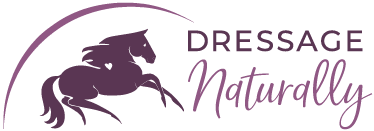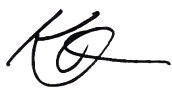Ordinary horses don't know they're ordinary. Every day, help your horse feel like the champion that he is.
A lot of students are underestimating just how much dressage they can do with their ‘ordinary’ horses.
I want to show all of you that having an ordinary horse is not only not holding you back from having an amazing dressage experience, but I will also make my case that sometimes the fastest way to excellence is by starting with ‘good enough’. (life lesson alert: that is true for other things too).
My hope is that by reading this it gives some of you hope, inspiration, and motivation to give your average horse a chance, and to make more informed choices when looking to purchase your dressage partner, because I also meet many students who have purchased (often under the advice of a professional), horses that are way ‘too much’ horse for them, because they thought a horse has to be ‘fancy’ in order to do dressage.
These students want to learn dressage, but they end up not riding at all. Students with average type horses often feel intimidated to take dressage lessons from a qualified professional, and sadly, many qualified professionals hesitate to take on someone with an average type horse especially if they don’t have competitive goals. The good news is that there are plenty of professionals who are interested in helping every level of student on every type of horse. Students just need to have the confidence in themselves to find the instructor that is right for them!
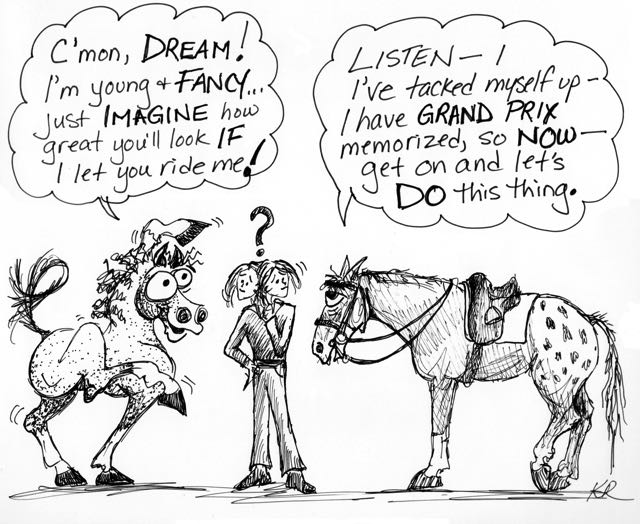
(This illustration by Karen Rohlf was originally published in Anne Gribbon's book: Collective Remarks Trafalgar Publishing)
First I need to explain that I am going to use the terms ordinary and fancy as a shorthand for horses that move, to use the dressage scoring system as a 5 or 6 mover (ordinary) or 7,8,9, or 10 movers (fancy). This is not going to be a dissertation on how to assess or arrive at these scores, but I think it will be clear enough if I just use these terms. An ordinary horse is one that you might not give a second glance or even notice if you were looking for a dressage horse, and a fancy horse is one you will stop and look at and say: ‘Really nice’ or ‘Wow’.
There have been many horses in my life that were not considered fancy but were incredibly fun, rewarding, competitive, educational, and correct in their dressage. Some very ordinary horses have taught their owners to go from zero dressage to Grand Prix. I taught a junior rider on a former school horse to get to Prix St Georges and be invited to a schooling session for juniors hosted by the United States Equestrian Federation. I have taught another junior on a 12 year old former jumper that couldn’t jump anymore, but no dressage trainers wanted him. He ended up representing the United States on the International Young Rider Team, and they went on to do Grand Prix.
I trained a horse that was a 4 mover (on a long rein he had an irregular trot and cross-fired relentlessly at what felt like a 5-beat canter) to do everything in Grand Prix and he gave his owner the education of her dreams. I even competed him at Fourth Level, got in the mid 60%’s and got a 7 for gaits! Currently I have a horse that was a champion at Western Pleasure (of all things). His nickname around my place is Barbie’s Dream Horse and he teaches people how to do piaffe, pirouettes, flying changes, lateral work, and to have the lightest touch... The first horse I did dressage on was an OTTB with an old bowed tendon who did not pass his pre-purchase exam. He was 7 years old and did hunter/jumper when I got him, I did Pony Club.
He went all the way and it was with him that I represented the USA 4 times at the Young Riders Championships. The year we won the individual Bronze medal I was the only one on a horse trained by his rider and that wasn’t a ‘fancy schoolmaster’. At the dressage facility I worked out of for 20 years we had a Grand Prix school master that was a leopard appaloosa/quarter horse stallion that looked like a bulldog. He had a throat latch so thick he could barely get on the vertical, and a stride so short he was almost standing still when he did his 15 one-tempis... But he did them, and he trained countless people to do all levels of dressage, and he also took students to very high level competitions.
OK, here are some thoughts:
The basics of dressage are about bringing out the best in any horse
The basics of dressage are for all horses. Dressage is a verb... It means training. At it’s heart it is about creating healthy movement. If you have a horse that needs improvement in the way he moves, then you are absolutely doing dressage. If you are diligent and focused, you likely will end up understanding the heart of dressage even more than if you only rode horses that are naturally cadenced and balanced. Philippe Karl says: The measure of a system is not how it works with the most talented, but how well it works with the least talented.” To do dressage, to me, is to love to educate horses to improve their natural gaits. So if you find you are being trained by someone and it feels like your horse doesn’t fit in their system, then perhaps you need to find a system that fits your horse. Basic dressage training should serve the horse, not the other way around. As a trainer I am always finding a way to adjust what I do in order for the horse to learn.
When I was in training to be a dressage judge I had the privilege of being taught by Edgar Hotz (a judge who had a huge impact on dressage judging in the USA). He taught us that when there was a tie score, he would break the tie by looking at the gait score, and the winner of the tie was the horse with the lower score for gaits, because that meant that the actual dressage was better.
With that said, if your aspirations are to definitely make it to the upper levels, or win competitions, you will want to make sure the horse doesn’t have too many strikes against him. It isn’t fair to force a horse with a biomechanical handicap to perform the most challenging dressage movements because you have this dream to perform some dressage miracles... But if you stay in the state of mind that your goal is to do your best to use dressage to make the horse the best he can be each day... You may just experience that miracle after all... Miracles are kind of like dressage... You can’t make them happen, but if you’re living right, they just happen on their own!
Ordinary horses don’t know they are ordinary
Dressage is about harmonious education and perfect understanding between horse and rider. That is where the magic is. It feels good to the horse and the human. Much of the amazingness that is dressage can be felt with the vast majority of horses... The feeling of one body, the feeling of balance, freedom, lightness, of communication, of being able to perform precise patterns and movements that you couldn’t do before, the feeling that each of you is doing something that neither of you could do on your own, and sharing those magical ‘Yes Moments’ feels incredible. Any horse can feel that, and feel proud of himself. And that can be equally satisfying for the rider.
The horse won’t feel any less proud if a ‘better mover’ trots by, and neither should you. Definitely don’t make your horse feel like he is not the best horse in the world. Let me put that in the positive: Help your horse feel like the champion that he is every day. Don’t let your education about what a fancy international quality horse looks like make you feel bad about your horse doing his best... Just close your eyes, feel... Stay in the bubble that is you and your horse. That’s all that matters to him.
Every time I get on a horse I have to adjust to who I am riding. I have felt internationally competitive quality of movement. I have sat on the super-athlete, but when I get on an ordinary horse I have to adjust and continue to focus on the partnership, communication, biomechanical dynamic, and precision of the movements. When you focus on that you can feel some pretty extraordinary things from very ordinary horses.
And for those of you who do have fancy horses, you also need to stay focused on the partnership, communication, biomechanical dynamic, and precision of the movements. The ‘lesser’ quality moving horses, or the ‘less talented’ horses HAD to be truly educated. They simply couldn’t fake it. Many a fancy horse can get through the lower levels cruising on their good looks; looking fabulous, and scoring well, (even if they felt mostly out of control). The trouble is that often this leads to a melt down at Third or Fourth Level if partnership and communication aren’t established.
Often I have to tell myself, and students, when riding the fancy horses: “Try to feel the dynamic of communication... And ask yourself how this would feel if you were riding a really boring flat mover”. In other words, to me, Fancy Is As Fancy Does and maybe it’s a blessing in disguise that if our flat boring moving horse careens through his corners we tend to address it right away, but if a fancy moving horse careens in a floating, powerful, way with a 3 hoof print over-stride and an arched neck we tend to burst out in applause. Focus on partnership and communication and you will nurture the kind of fancy that you really want!
You need a horse with ‘good enough’, clean gaits.
From there, build communication and skills that will allow you to do the movements that build your horse gymnastically.
Dressage can help any horse, but in order to go on in dressage you need to have ‘good enough’ gaits. So if you have a horse with major rhythm flaws (a lateral walk, irregular trot, and lateral or 4-beat canter), the first order of business is to use dressage to get three clean gaits. If the rhythm is not clean then it will actively get in the way of performing some movements.
In dressage judging, gaits and movements are scored on a scale from 1-10. A 4 is considered insufficient, a 5 is marginal, and a 6 is satisfactory. Below 4 you get into ranges of ‘badness’ and above 6 is the range from ‘fairly good’ all the way up to ‘excellent’.
5 is on the edge. 6 means you have one drop of quality. When you see a horse moving for a 5 you may think: ‘Eh’ or ‘almost’. When you see a 6 you will think: ‘Nice!’ You won’t think: ‘Wow!’ but you also won’t think: ‘Yuck.’
The biggest, fanciest moving super-athlete horses are often not the easiest to ride or train. To learn on one of those horses riders really have to step up their game mentally, emotionally, and physically. It can be challenging and demanding, but if getting oohs and ahhs from the crowd as you try to figure out how the heck to sit such a tremendous trot, or if you don’t mind the look of fright you have on your face when the horse canters, then with time and dedication it could work. Lots of students can do this... Just make sure YOU are ready for this because if a horse moves for a 10 and you can only sit for a 5 you are restricting your horse. If your horse lives in a state of power and you are living in a state of fear, you may not feel comfortable on him and you are going to restrict your horse.
Creating movement for a ‘6’ is an important starting point, and as I will show you, there is more power in that ‘6’ than you may think!
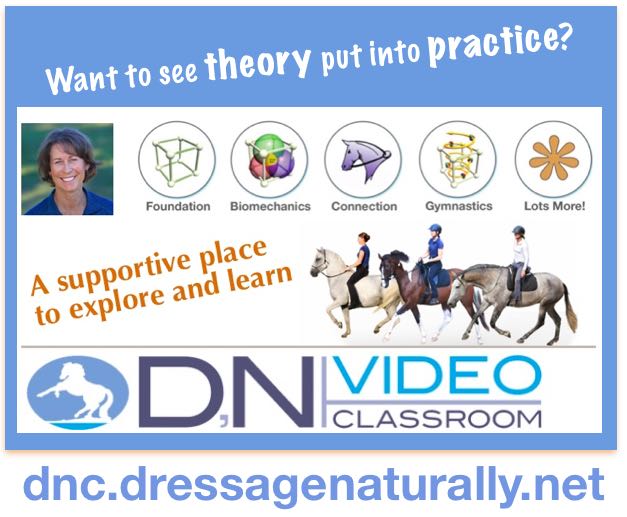 '6 With Ease'... Starting with a 6 is sometimes the fastest way to a 10
'6 With Ease'... Starting with a 6 is sometimes the fastest way to a 10
I tell my students (and I follow this myself when I train) that the goal is to ride for a ‘6 with ease’ (6WE). If you have a horse that already moves for an 8, riding a 6WE will allow you to relax and focus on the ease part. Things like brilliance and power are a result of energy plus relaxation, so the ease of movement is what will allow the brilliance to come out. When you ride an 8 mover thinking about getting a 6WE, you usually are still moving for an 8, but it is, well, easier! AND because of the greater harmony and relaxation, it will help you get better transitions, so the transition scores often go up too.
If you have a horse that only moves for a 5, riding a 6WE will help you make sure you find that one notch more quality that will hep you achieve the gymnastic dynamic that will open the door towards further progress, but without pushing too much into tension. By building the horse’s mental and physical confidence at a 6 with ease, you give him a chance to strengthen his ‘6’, and his gaits will naturally improve from that strength and confidence... Also, because you are not riding him over his limit, transitions will be better.
Transitions count. A lot. If you do two movements for a 6, but you transition between them really really smoothly, with invisible aids, right on the mark, with no resistance or hesitation, you can get some really nice scores!
Even if his gaits never improve past a 6, and none of your movements or transitions ever get more than a6, you can still get a 60% at any level. That is great! You can even get awards at 60%! Would you like to get a 60% at Grand Prix? That could be possible!
There are many ways to get a 7
Maybe you are thinking: ‘6 is nice, but 7 is better’. But there are many ways to arrive at a 7. You can get a 7 by doing a 6 with ease and letting the 7 come out of quality... Or you could start with an 8 and ride it with decreasing quality until you end up with a 7. I find many students who have a horse that is ‘more horse’ than they are truly comfortable with can still get decent scores, but if they are getting 7’s by riding a decreased 8 it may be nice to have the ribbon or the score, but often something doesn’t feel right on the inside. Everyone tells you it looks good, but it doesn’t feel good because you feel the resistance, or imbalance. And because of the disharmony created, often it ends up a 6 (with dis-ease) eventually anyway due to the habits you are forming.
As a student it is so important to be able to trust your instincts and build confidence. I would always recommend feeling super confident and sure that you are ‘owning’ your 6, than to feel unconfident, confused, and out of harmony with your horse but still getting a 7 because he happens to be such a nice mover. Based on years of experience teaching and working with students on a long-term basis on all types of horses, it is much easier to take a rider who confidently can ride with ease on a horse who ‘maxes out’ at 6, and move them on to a better mover later, than it is to try to keep the confidence high in a rider who is ‘decreasing’ into a 7 or 6 because there is struggle or brace. These students often feel more frustration and lose motivation. They also feel even worse about themselves because they have such a ‘nice horse’ (which they may have spent a lot of money on) but can’t seem to ride it well.
You need a horse with gaits not too much bigger than you can ride
My advice is to have a horse with gaits that you can ride! If your horse moves for a 5 and you can sit for an 8 then you will be a great asset to your horse! If your horse moves for an 8 but you can only sit for a 5, then you will be a restriction for your horse. If you want to gain confidence, get a horse that is easy to sit. If you have a 6 mover that you can ride with ease, but he is ‘maxed out’ as far as how advanced he will be, or if you want to be more competitive and you are ready for a horse with more scopey or brilliant gaits... excellent!!! Get a horse that is only one notch more athletic than you are comfortable with. Keep in mind some fancy horses are comfortable and easy to sit, so don’t get too depressed, you CAN find a fancier horse that you feel comfortable on... Just make sure you think about that when you are looking. (in other words, buy one that you can sit on and try out.)
Then, know that you will need to put a big focus on upping your athleticism to keep up with him. This certainly can be done and it is so rewarding when you do. It is part of your education! But just know, that if you can’t follow your horse’s movement, learning to do so is going to be your first priority,. You will need to learn to sit him first, so if your goal was to get a really fancy moving horse to learn advanced dressage on, just be prepared to spend a lot of time not doing dressage movements, but just learning how to move with him. If you try to cut that corner it will bite you in the butt later (pun intended).
A horse that moves for a 6 can do GP
When you think GP don’t think of the Olympic horses... Often the top international competitors are the only Grand Prix horses students ever see. They assume that kind of movement and that level go together, but they don’t. It is possible to do everything in GP correctly and cleanly, on a very ordinary moving horse... And you can still get a 60% or often much more. Remember, a 60% means that a highly trained professional judge could watch you and say: ‘Nice’. I don’t know about you, but I think that would be pretty cool and satisfying!
When I first started rock climbing I remember being completely amazed that there were easy climbs that went all the way to the top. Somehow I thought that if you were a beginner climber you only went a little way up, and only the really great climbers went all the way to the top. But sure enough, I didn’t have to be a super fancy climber...There were cliff faces made just for me! I could be an ordinary climber and still get out there and get the full experience. No one made a documentary about me doing it, but the view from the top was just as good for me as it was for the guy who free-soloed it!
The goal of competition is to beat yesterday’s best with today’s best... Don’t compare your or your horse’s best to someone else’s best except as a way to inspire you.

I knew I was losing interest in competing when I found myself forgetting to check the score board. I would pick up my test and I loved reading the judges comments and scores, but my pride was in the improvement within the particular horse I was riding. Most of the time I already knew what had improved or not during the test. I have felt the feeling of one horse doing what I knew was his best, but not scoring as well as another horse I rode that was not doing well, but he still got the higher score. I realized I didn’t really care how any one horse compared to another. I only cared about how much a particular horse improved or performed to the standard.
Judges don’t like when that happens either. The scoring system tries to reward the best riding. In fact, the gait score is no longer multiplied by 2 like it used to be. They are de-emphasizing the gait and yet the impulsion and submission scores are times 2, which reflects dressage’s desire to reward the dynamic and not favor the better gaited horse. Still, it is complicated. Judges have to mark what they see, and things like elasticity and engagement have to be rewarded when they show up even if in the judge’s heart they know that one horse was showing miraculous elasticity considering who he is, and the other is showing a mere fraction of his potential due to restriction.
If your goal is set in stone to be highly competitive; if your plan is to campaign and your mission is to be nationally or internationally viable, then you will want to work hard to be able to ride the super athletes. It of course is the ultimate goal: To get a 10 on partnership, and communication on a horse that moves for a 10. But until then, you may be surprised at how much you can do with the average horse.
Focus on partnership, communication, a healthy biomechanical dynamic, and on understanding the purpose of dressage movements to develop your horse’s skills.
Relaxation, calmness, effortlessness, and communication IS brilliance.
Partnership is brilliance. Harmony is brilliance.
To love dressage is to love a process. It is a verb, not a noun. Find a way to love the process you have with your horse.
Do your best to make your best better and better. Don’t compare your horse to others except to learn or be inspired. Everyday find a way to help your horse feel like a champion. That way, whether you make it to Training, First, Fourth Level, or all the way to Grand Prix, you will be successfully doing dressage.


Jedi - a.k.a. "Barbie's Dream Horse" ... From western pleasure champion, to dressage schoolmaster.

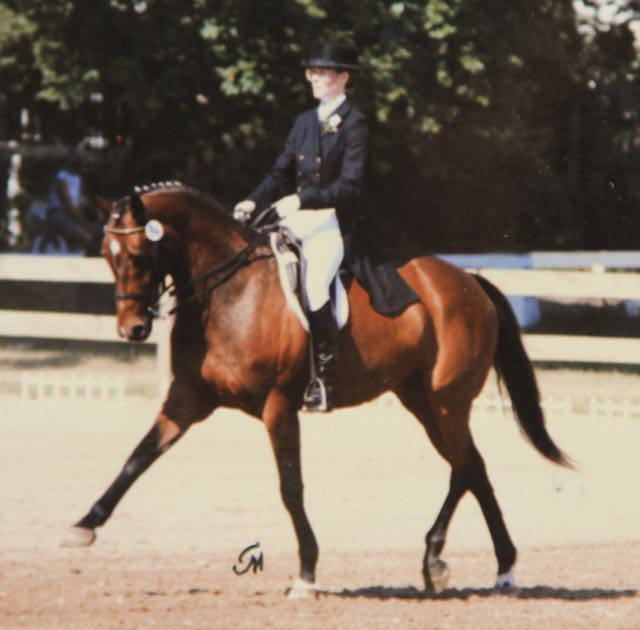
Brave Tom - An extraordinary ordinary horse that got a chance to show the world his inner champion!
